Citroen DS4 RHD 2013.5 1.G Owner's Manual
Manufacturer: CITROEN, Model Year: 2013.5, Model line: DS4 RHD, Model: Citroen DS4 RHD 2013.5 1.GPages: 400, PDF Size: 31.86 MB
Page 181 of 400
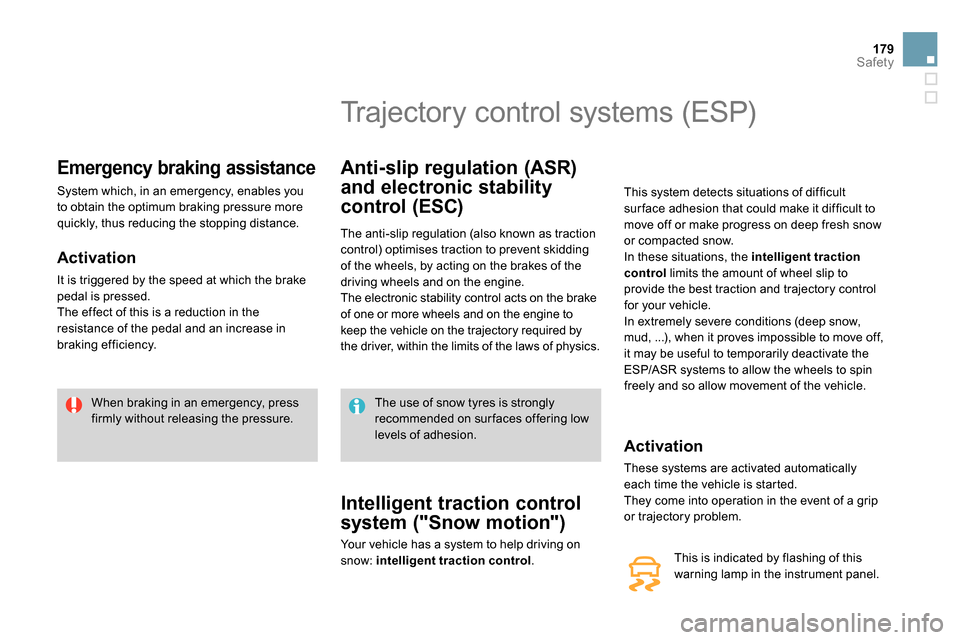
179Safety
Emergency braking assistance
System which, in an emergency, enables you
to obtain the optimum braking pressure more
quickly, thus reducing the stopping distance.
Activation
It is triggered by the speed at which the brake
pedal is pressed.
The effect of this is a reduction in the
resistance of the pedal and an increase in
braking efficiency.
When braking in an emergency, press
firmly without releasing the pressure.
Trajectory control systems (ESP)
Anti-slip regulation (ASR)
and electronic stability
control (ESC)
The anti-slip regulation (also known as traction
control) optimises traction to prevent skidding
of the wheels, by acting on the brakes of the
driving wheels and on the engine.
The electronic stability control acts on the brake
of one or more wheels and on the engine to
keep the vehicle on the trajectory required by
the driver, within the limits of the laws of physics.
Activation
These systems are activated automatically
each time the vehicle is started.
They come into operation in the event of a grip
or trajectory problem.
This is indicated by flashing of this
warning lamp in the instrument panel.
Intelligent traction control
system ("Snow motion")
Your vehicle has a system to help driving on
snow: intelligent traction control.
The use of snow tyres is strongly
recommended on sur faces offering low
levels of adhesion.
This system detects situations of difficult
sur face adhesion that could make it difficult to
move off or make progress on deep fresh snow
or compacted snow.
In these situations, the intelligent traction
control
limits the amount of wheel slip to
provide the best traction and trajectory control
for your vehicle.
In extremely severe conditions (deep snow,
mud, ...), when it proves impossible to move off,
it may be useful to temporarily deactivate the
ESP/ASR systems to allow the wheels to spin
freely and so allow movement of the vehicle.
Page 182 of 400
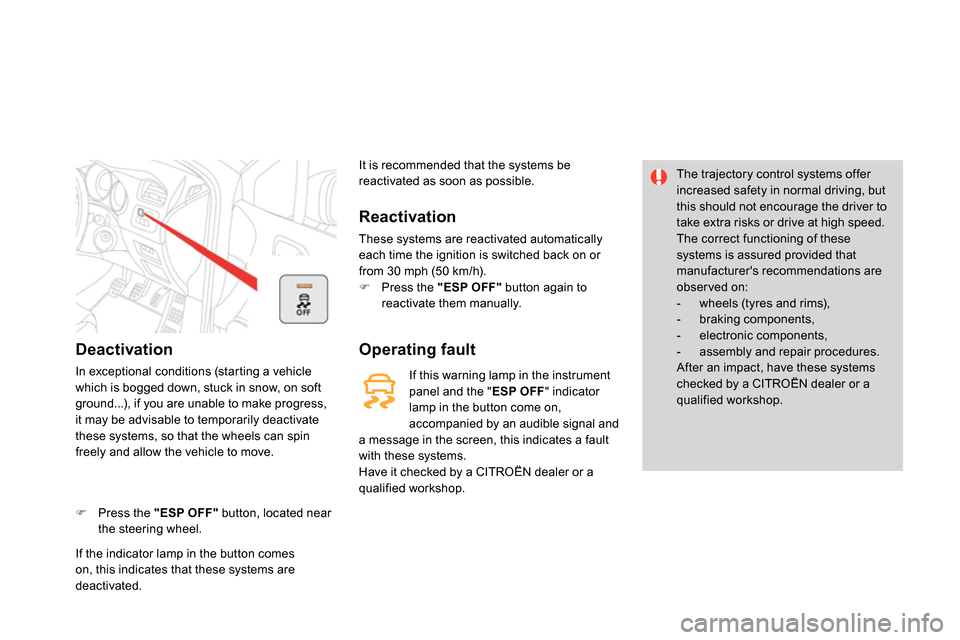
Deactivation
In exceptional conditions (starting a vehicle
which is bogged down, stuck in snow, on soft
ground...), if you are unable to make progress,
it may be advisable to temporarily deactivate
these systems, so that the wheels can spin
freely and allow the vehicle to move.
Press the "ESP OFF"
button, located near
the steering wheel.
Reactivation
These systems are reactivated automatically
each time the ignition is switched back on or
from 30 mph (50 km/h).
Press the "ESP OFF"
button again to
reactivate them manually.
Operating fault
The trajectory control systems offer
increased safety in normal driving, but
this should not encourage the driver to
take extra risks or drive at high speed.
The correct functioning of these
systems is assured provided that
manufacturer's recommendations are
observed on:
- wheels (tyres and rims),
- braking components,
- electronic components,
- assembly and repair procedures.
After an impact, have these systems
checked by a CITROËN dealer or a
qualified workshop.
If this warning lamp in the instrument
panel and the " ESP OFF
" indicator
lamp in the button come on,
accompanied by an audible signal and
a message in the screen, this indicates a fault
with these systems.
Have it checked by a CITROËN dealer or a
qualified workshop. It is recommended that the systems be
reactivated as soon as possible.
If the indicator lamp in the button comes
on, this indicates that these systems are
deactivated.
Page 183 of 400
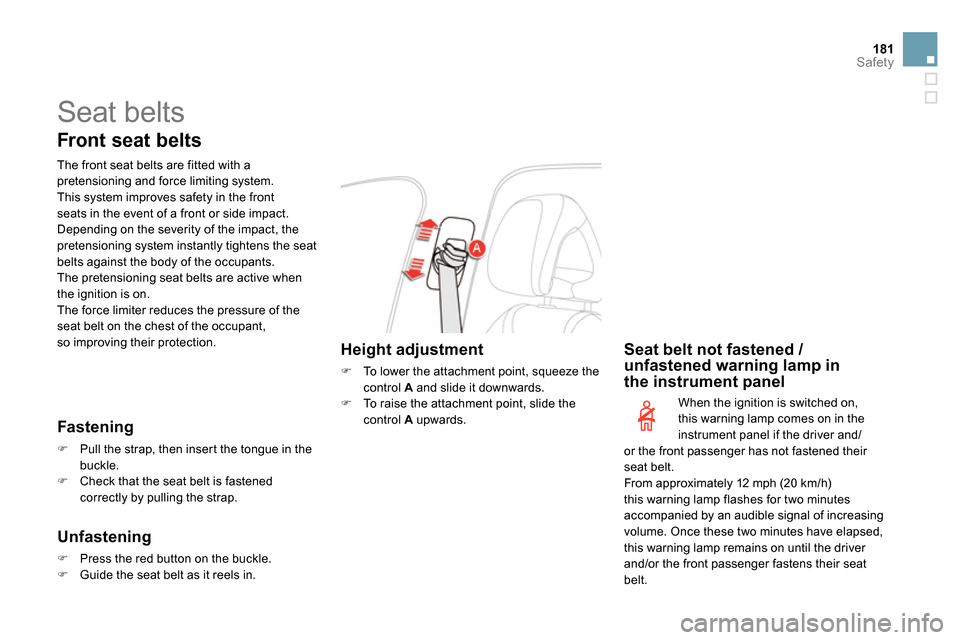
181Safety
Seat belts
Front seat belts
The front seat belts are fitted with a
pretensioning and force limiting system.
This system improves safety in the front
seats in the event of a front or side impact.
Depending on the severity of the impact, the
pretensioning system instantly tightens the seat
belts against the body of the occupants.
The pretensioning seat belts are active when
the ignition is on.
The force limiter reduces the pressure of the
seat belt on the chest of the occupant,
so improving their protection.
Fastening
Pull the strap, then insert the tongue in the
buckle.
Check that the seat belt is fastened
correctly by pulling the strap.
Unfastening
Press the red button on the buckle.
Guide the seat belt as it reels in.
Seat belt not fastened /
unfastened warning lamp in
the instrument panel
When the ignition is switched on,
this warning lamp comes on in the
instrument panel if the driver and/
or the front passenger has not fastened their
seat belt.
From approximately 12 mph (20 km/h)
this warning lamp flashes for two minutes
accompanied by an audible signal of increasing
volume. Once these two minutes have elapsed,
this warning lamp remains on until the driver
and/or the front passenger fastens their seat
belt.
Height adjustment
To lower the attachment point, squeeze the
control A
and slide it downwards.
To raise the attachment point, slide the
control A
upwards.
Page 184 of 400
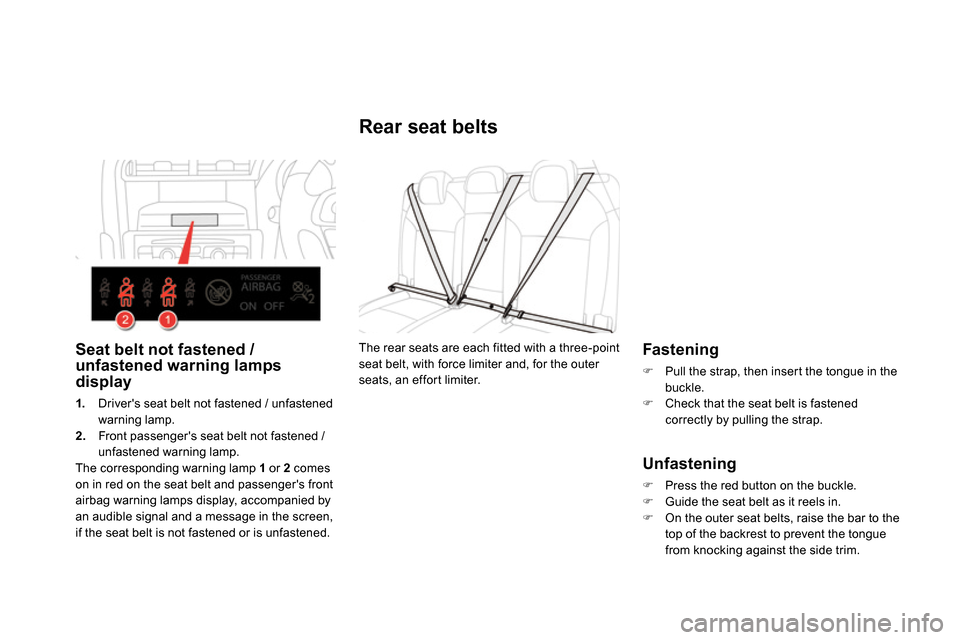
Rear seat belts
Fastening
Pull the strap, then insert the tongue in the
buckle.
Check that the seat belt is fastened
correctly by pulling the strap.
Unfastening
Press the red button on the buckle.
Guide the seat belt as it reels in.
On the outer seat belts, raise the bar to the
top of the backrest to prevent the tongue
from knocking against the side trim.
The rear seats are each fitted with a three-point
seat belt, with force limiter and, for the outer
seats, an effort limiter.
Seat belt not fastened /
unfastened warning lamps
display
1.
Driver's seat belt not fastened / unfastened
warning lamp.
2.
Front passenger's seat belt not fastened /
unfastened warning lamp.
The corresponding warning lamp 1
or 2
comes
on in red on the seat belt and passenger's front
airbag warning lamps display, accompanied by
an audible signal and a message in the screen,
if the seat belt is not fastened or is unfastened.
Page 185 of 400
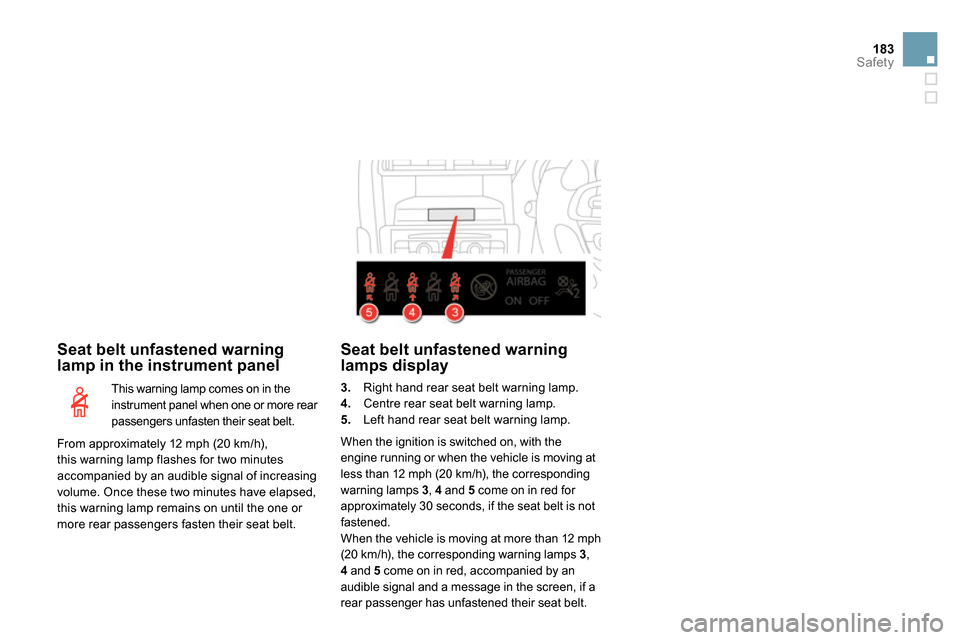
183Safety
Seat belt unfastened warning
lamp in the instrument panel
This warning lamp comes on in the
instrument panel when one or more rear
passengers unfasten their seat belt.
Seat belt unfastened warning
lamps display
3.
Right hand rear seat belt warning lamp.
4.
Centre rear seat belt warning lamp.
5.
Left hand rear seat belt warning lamp.
When the ignition is switched on, with the
engine running or when the vehicle is moving at
less than 12 mph (20 km/h), the corresponding
warning lamps 3
, 4
and 5
come on in red for
approximately 30 seconds, if the seat belt is not
fastened.
When the vehicle is moving at more than 12 mph
(20 km/h), the corresponding warning lamps 3
,
4
and 5
come on in red, accompanied by an
audible signal and a message in the screen, if a
rear passenger has unfastened their seat belt.
From approximately 12 mph (20 km/h),
this warning lamp flashes for two minutes
accompanied by an audible signal of increasing
volume. Once these two minutes have elapsed,
this warning lamp remains on until the one or
more rear passengers fasten their seat belt.
Page 186 of 400
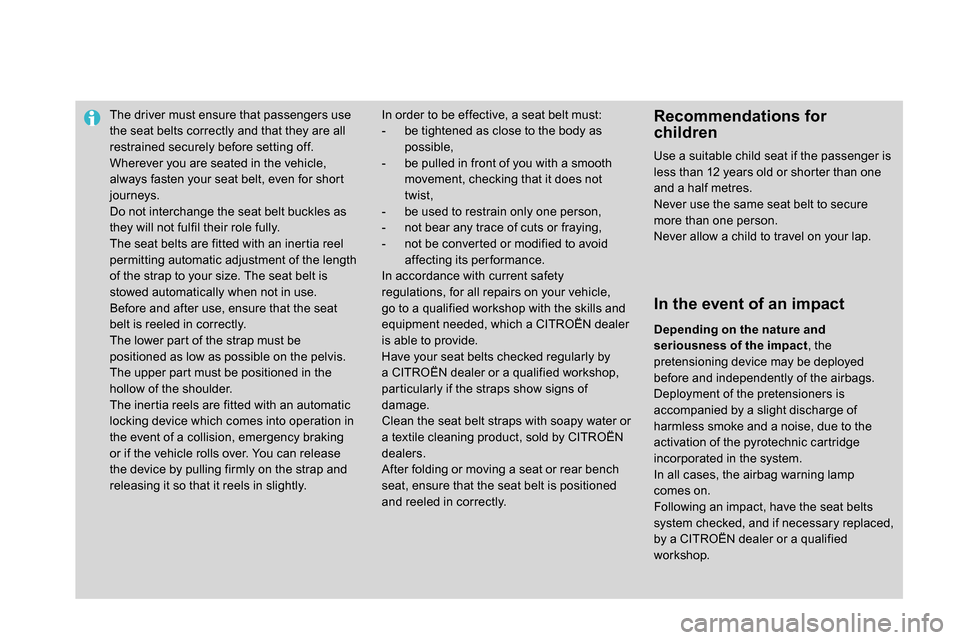
The driver must ensure that passengers use
the seat belts correctly and that they are all
restrained securely before setting off.
Wherever you are seated in the vehicle,
always fasten your seat belt, even for short
journeys.
Do not interchange the seat belt buckles as
they will not fulfil their role fully.
The seat belts are fitted with an inertia reel
permitting automatic adjustment of the length
of the strap to your size. The seat belt is
stowed automatically when not in use.
Before and after use, ensure that the seat
belt is reeled in correctly.
The lower part of the strap must be
positioned as low as possible on the pelvis.
The upper part must be positioned in the
hollow of the shoulder.
The inertia reels are fitted with an automatic
locking device which comes into operation in
the event of a collision, emergency braking
or if the vehicle rolls over. You can release
the device by pulling firmly on the strap and
releasing it so that it reels in slightly. In order to be effective, a seat belt must:
- be tightened as close to the body as
possible,
- be pulled in front of you with a smooth
movement, checking that it does not
twist,
- be used to restrain only one person,
- not bear any trace of cuts or fraying,
- not be converted or modified to avoid
affecting its per formance.
In accordance with current safety
regulations, for all repairs on your vehicle,
go to a qualified workshop with the skills and
equipment needed, which a CITROËN dealer
is able to provide.
Have your seat belts checked regularly by
a CITROËN dealer or a qualified workshop,
particularly if the straps show signs of
damage.
Clean the seat belt straps with soapy water or
a textile cleaning product, sold by CITROËN
dealers.
After folding or moving a seat or rear bench
seat, ensure that the seat belt is positioned
and reeled in correctly.
Recommendations for
children
Use a suitable child seat if the passenger is
less than 12 years old or shorter than one
and a half metres.
Never use the same seat belt to secure
more than one person.
Never allow a child to travel on your lap.
In the event of an impact
Depending on the nature and
seriousness of the impact
, the
pretensioning device may be deployed
before and independently of the airbags.
Deployment of the pretensioners is
accompanied by a slight discharge of
harmless smoke and a noise, due to the
activation of the pyrotechnic cartridge
incorporated in the system.
In all cases, the airbag warning lamp
comes on.
Following an impact, have the seat belts
system checked, and if necessary replaced,
by a CITROËN dealer or a qualified
workshop.
Page 187 of 400
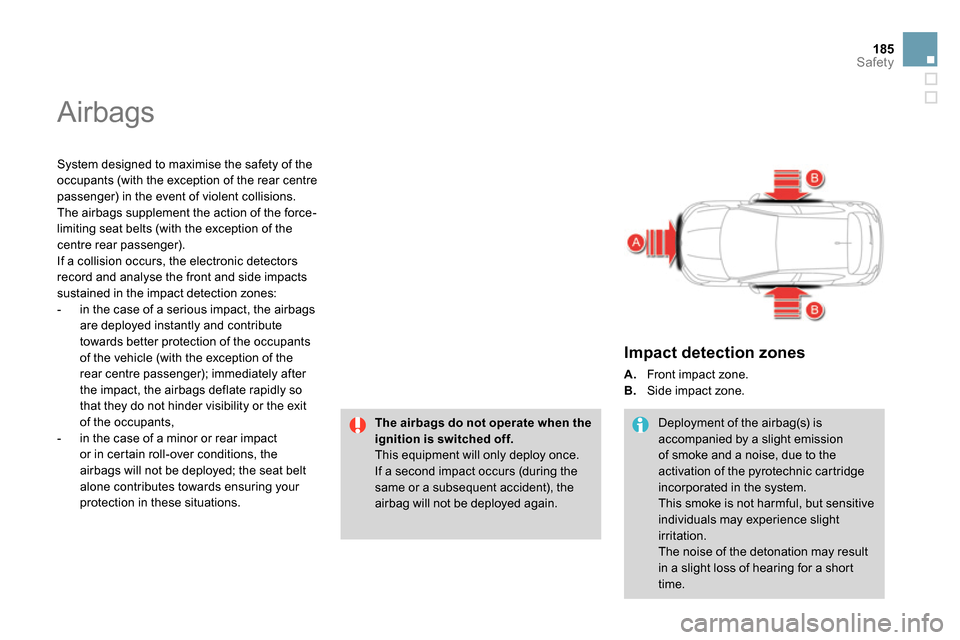
185Safety
Airbags
System designed to maximise the safety of the
occupants (with the exception of the rear centre
passenger) in the event of violent collisions.
The airbags supplement the action of the force-
limiting seat belts (with the exception of the
centre rear passenger).
If a collision occurs, the electronic detectors
record and analyse the front and side impacts
sustained in the impact detection zones:
- in the case of a serious impact, the airbags
are deployed instantly and contribute
towards better protection of the occupants
of the vehicle (with the exception of the
rear centre passenger); immediately after
the impact, the airbags deflate rapidly so
that they do not hinder visibility or the exit
of the occupants,
- in the case of a minor or rear impact
or in certain roll-over conditions, the
airbags will not be deployed; the seat belt
alone contributes towards ensuring your
protection in these situations.
The airbags do not operate when the
ignition is switched off.
This equipment will only deploy once.
If a second impact occurs (during the
same or a subsequent accident), the
airbag will not be deployed again.
Impact detection zones
A.
Front impact zone.
B.
Side impact zone.
Deployment of the airbag(s) is
accompanied by a slight emission
of smoke and a noise, due to the
activation of the pyrotechnic cartridge
incorporated in the system.
This smoke is not harmful, but sensitive
individuals may experience slight
irritation.
The noise of the detonation may result
in a slight loss of hearing for a short
time.
Page 188 of 400
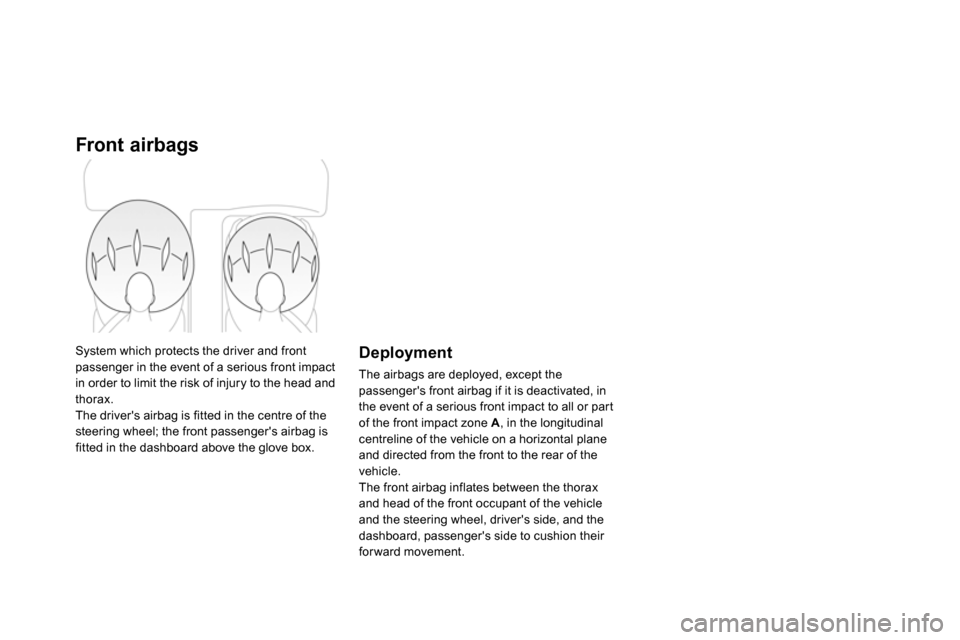
Front airbags
System which protects the driver and front
passenger in the event of a serious front impact
in order to limit the risk of injury to the head and
thorax.
The driver's airbag is fitted in the centre of the
steering wheel; the front passenger's airbag is
fitted in the dashboard above the glove box.
Deployment
The airbags are deployed, except the
passenger's front airbag if it is deactivated, in
the event of a serious front impact to all or part
of the front impact zone A
, in the longitudinal
centreline of the vehicle on a horizontal plane
and directed from the front to the rear of the
vehicle.
The front airbag inflates between the thorax
and head of the front occupant of the vehicle
and the steering wheel, driver's side, and the
dashboard, passenger's side to cushion their
for ward movement.
Page 189 of 400
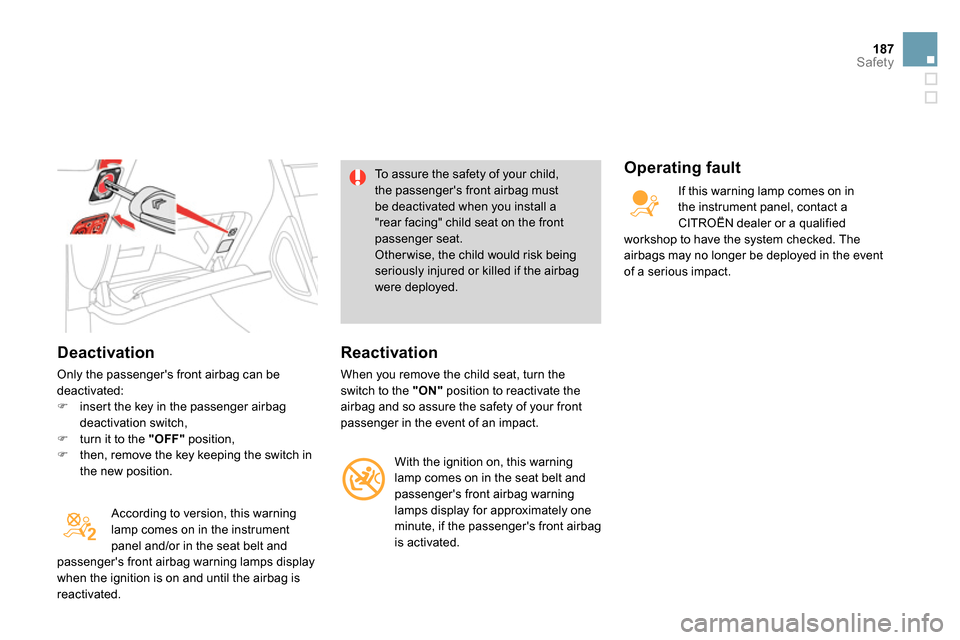
187Safety
Deactivation
Only the passenger's front airbag can be
deactivated:
insert the key in the passenger airbag
deactivation switch,
turn it to the "OFF"
position,
then, remove the key keeping the switch in
the new position.
According to version, this warning
lamp comes on in the instrument
panel and/or in the seat belt and
passenger's front airbag warning lamps display
when the ignition is on and until the airbag is
reactivated. To assure the safety of your child,
the passenger's front airbag must
be deactivated when you install a
"rear facing" child seat on the front
passenger seat.
Other wise, the child would risk being
seriously injured or killed if the airbag
were deployed.
Reactivation
When you remove the child seat, turn the
switch to the "ON"
position to reactivate the
airbag and so assure the safety of your front
passenger in the event of an impact.
With the ignition on, this warning
lamp comes on in the seat belt and
passenger's front airbag warning
lamps display for approximately one
minute, if the passenger's front airbag
is activated.
Operating fault
If this warning lamp comes on in
the instrument panel, contact a
CITROËN dealer or a qualified
workshop to have the system checked. The
airbags may no longer be deployed in the event
of a serious impact.
Page 190 of 400
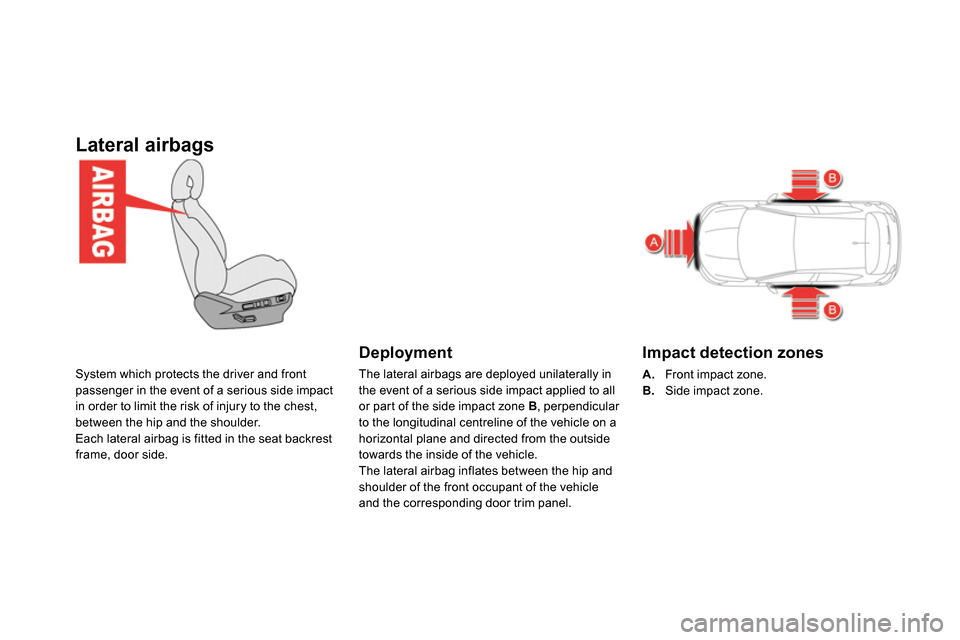
Lateral airbags
System which protects the driver and front
passenger in the event of a serious side impact
in order to limit the risk of injury to the chest,
between the hip and the shoulder.
Each lateral airbag is fitted in the seat backrest
frame, door side.
Deployment
Impact detection zones
A.
Front impact zone.
B.
Side impact zone.
The lateral airbags are deployed unilaterally in
the event of a serious side impact applied to all
or part of the side impact zone B
, perpendicular
to the longitudinal centreline of the vehicle on a
horizontal plane and directed from the outside
towards the inside of the vehicle.
The lateral airbag inflates between the hip and
shoulder of the front occupant of the vehicle
and the corresponding door trim panel.